Miyajima
Miyajima (宮島) is one of the crown jewels of Japan, and certainly one of its finest views. Located off the coast of Hiroshima, the serene beauty of the island is an essential coda to that city.
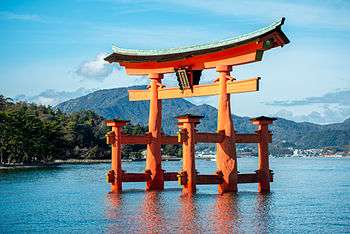
Understand
Miyajima has been considered a holy place for most of Japanese history. In 806 AD, the monk Kōbō Daishi ascended Mt. Misen and established the mountain as an ascetic site for the Shingon sect of Buddhism. In the years since, the island's Buddhist temples and Shinto shrines have maintained a close relationship.
In the past, women were not allowed on the island and old people were shipped elsewhere to die, so that the ritual purity of the site would not be spoiled; in fact, the island's real name is Itsukushima (厳島, Solemn/Strict Island), and Miyajima is just a popular nickname meaning "Shrine Island".
These days, strict measures are taken to ensure that the island's sole town retains a classically Japanese Edo-era look. Deer wander freely through the streets and parks. There are still a few bits of concrete warren that have snuck in, but the seafront promenade is particularly attractive, especially later in the day when the rampaging tour groups head home and the stone lanterns are lit.
- Miyajima Tourist Association, 1162-18 Miyajima-cho (in the ferry building), ☎ +81 829-44-2011.
Get in
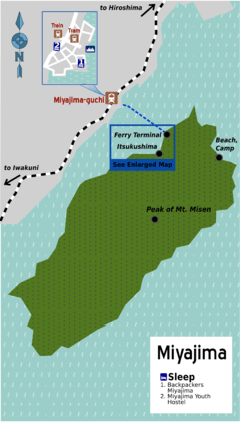
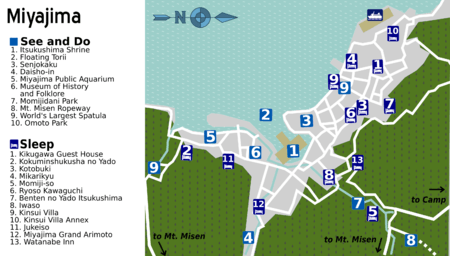
Miyajima can be reached by sea from Hiroshima. The main ferry terminal on the mainland is Miyajimaguchi (宮島口), which can be reached from JR Hiroshima station either by train (¥400, 25 minutes, or ¥570 for a combination ticket with the ferry) or tram line #2 (¥270, 70 minutes). The tram line also passes by the Peace Memorial Park.
From Miyajimaguchi, JR ferries and Matsudai ferries run to Miyajima up to 10 times per hour. The trip takes 10 minutes and costs ¥180 each way; Japan Rail Pass holders can use the JR ferry for free. The last ferry returns to the mainland at 10:40PM. Most tour groups are gone after 5PM, so you'll have a different experience on the island if you wait them out.
There are also direct ferry connections from the Motoyasubashi Pier of the Hiroshima Peace Park, run by Aqua Net, with departures once per hour between 8:50AM and 6:50PM (returns between 9AM and 5:05PM). The boat is confining with small windows, which can, at times, get rather rough. Passengers are not allowed outside of the boat interior. It takes about 50 minutes and while it provides easy access from Peace Park to the pier, it provides little scenic access due to window size. They charge a steep ¥1900 one-way, ¥1500 return (half-price for children). Direct connections are also available from Ujina Port in Hiroshima, allowing connections with Matsuyama.
There is another ferry which can be caught from Hiroshima port, stopping at the Rprince Hotel. It is more expensive than the other ferries, costing ¥3100 for a return journey, but it does take a slightly more scenic route.
No bridges connect Miyajima to the mainland. Some ferries will carry automobiles and motorcycles, but parking on the island is expensive and difficult to find, unless arranged in advance with a hotel on the island, and most of the sights can't be reached by car. Quite a few of the hotels are willing to pick guests up from the pier with advance notice, though.
Get around
Miyajima is small enough to cover by foot, and there are English-language signs throughout the island. Taxis can be taken from the pier to the hotels and residential areas, but not the tourist sights.
The Miyajima free pass (¥2000) includes unlimited travel on the Mt. Misen ropeway, the ferry, and Hiroshima street cars for two days, so it is a good deal even if you only plan on taking the ferry and the ropeway (ropeway = ¥1800, ferry approximately ¥150 each way). It's available from the Hiroshima tourist office, and also from the conductors on the trams (recommended as it will save you time).
See
Standing in the bay in front of the shrine, the floating torii is the "gate" to Itsukushima. Whether the gate is "floating" or merely mired in mud depends on the tide. The Hiroshima tourist information office will be able to tell you the approximate time of the high tide (or you can check here), which is the best time to see the torii. If you spend a full day on the island, though, you should have the chance to see it both ways.
- 🌍 Itsukushima Shrine (厳島神社). Mar-Oct 6:30AM-6PM, Nov 6:30AM-5:30PM, Dec 6:30AM-5PM, Jan-Feb 6:30AM-5:30PM. A UNESCO World Heritage Site, Itsukushima is a large, red-lacquered complex of halls and pathways on stilts. It was built this way so that commoners could visit without defiling the island with their footprints. Weddings are occasionally held at the shrine, but that doesn't bar visitors, and the priest's ceremonial dance is a memorable sight. ¥300 for temple entry, ¥500 for entry plus Treasure Hall.
- 🌍 Senjokaku (千畳閣). The name means "1000 Mat Pavilion", a fairly apt description of this gigantic wooden hall which doesn't actually contain much other than empty space. It was started by Toyotomi Hideyoshi in 1587, but left incomplete after his death. There's also a picturesque 5-story pagoda (五重塔 Gojuto) next door, and plenty of cherry trees if you are visiting in sakura season. ¥100.
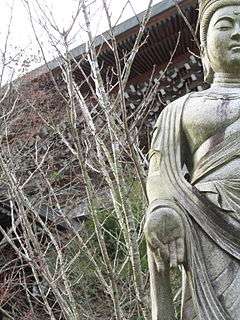
- 🌍 Daisho-in (大聖院), ☎ +81 829-44-0111. Because it's nestled into the hills, this Buddhist temple is easily missed by tourists, but it features a number of interesting sights and a welcome respite from the crowds. Look for the Dai-hannyakyo Sutra (大般若経), the golden prayer wheels that are said to bring enormous fortune to anyone who touches them, and the Henjokutsu Cave (遍照窟), a fascinating and eerie collection of Buddhist icons related to the 88 Temple Pilgrimage in Shikoku. Free.
- 🌍 Miyajima Public Aquarium (宮島水族館), 10-3 Miyajima-cho, ☎ +81 829-44-2010. 8:30AM-5PM daily. A collection of more than 350 sea creatures and daily animal events such as seal shows and penguin marches. It's worth a stop if you have restless kids in tow — about a 20-minute walk from the pier. ¥1050.
- Museum of History and Folklore (宮島歴史民俗資料館), 57 Miyajima-cho, ☎ +81 829-44-2019. Tu-Su 8:30AM-5PM. A small, charming collection of folk crafts and pieces of Miyajima history, many donated by locals. The main building was built as the residence of a soy sauce mogul about 170 years ago, and has a traditional garden out back. ¥300 (¥170/150 for children).
Do
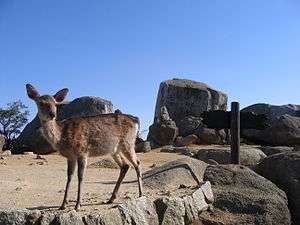
- 🌍 Mt. Misen (弥山) (530 meters). If you have energy to spare, Mt. Misen offers gorgeous views of the island and sea. The hike takes about an hour, depending on rest stops along the way. Look for the signs for the ropeway, and when you reach it, just keep going. There is a less used, slightly more strenuous (and more rewarding) route called the Omoto Pass that begins in the mossy park near the aquarium. Those with less energy (or inclination) can cheat and take the ropeway to an observatory near the top and hike from there (¥1000 one way, ¥1800 round trip). The ropeway closes at 5PM (last car down 5:30PM). It is a 30-minute walk from the end of the ropeway to Mt Misen, you have to climb about 150 height meters after going down the first ten minutes.
- Momijidani Park (紅葉谷公園). The ropeway station is in the middle of Momijidani Park, but the park is worth a stroll even if you're not headed up. Known for its autumn colors, there are quite a few quiet little temples to explore along the way, and many of the island's hotels are tucked away here.
- Making Momiji Manju. Inside the Shishiiwa Station of the ropeway, on the second floor, there is a chance to make your own momiji manju, a fun way to end the ropeway trip. The price is ¥300 per person, but if you are a couple they will give you a slight discount of ¥500. It takes about 20 minutes to make the momiji manju, and the workshop starts every 30 minutes from 10AM until 3:30PM with a 1½-hour break from noon until 1:30PM. You need to register first, but that's easy to do. Just go to the coffee area near the vending machine and ask to put your name down and pay. Although it may sound a little cheesy, the results are delicious and by far the most enjoyable and cheap snack to be found before heading back down the ropeway.
Buy
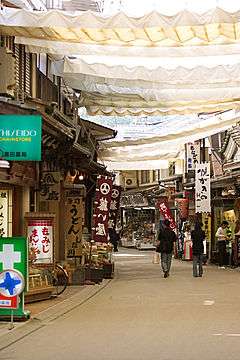
Oddly enough, Miyajima is well-known for its rice scoops (杓子 shakushi), spatula-esque wooden spoons used to serve cooked rice. You can even gaze upon the World's Largest Spatula (well over 5 meters long), showcased along Omotesando, the main shopping street.
The sheer number of souvenir shops is mind-boggling. For the most part, they all sell the same things for the same prices — rice scoops, miniature floating toriis, and souvenir boxes of sweets are by far the most common items. (Even Hello Kitty has her own Miyajima-themed shop on Omotesando.) However, the path between the port from Momijidani Park has a few statuaries and art dealers with impressive wares and similarly impressive prices.
Another local treat is deer shit (鹿の糞). Not the real thing, mind you; it's just a crunchy chocolate in the shape of droppings. It's delicious and will surely take center stage when Grandma asks your kids what they did in Japan.
Eat and drink
There are many little restaurants and vendors in the shopping streets near the shrine. As a rule of thumb, anything out by the seafront in the restored classical houses will be expensive, while the simpler eateries in the streets will be cheaper. Refreshments are also available atop Mt. Misen, with the usual top-of-a-mountain surcharge. Most public restaurants close around 17:00, so travellers staying overnight should plan to have dinner at their hotels or stock up on snacks. Most hotels also have lounges with drinks available.
If you don't eat seafood, be sure to notify your hotel well in advance, as that's almost certainly on the menu. Oysters are a popular dish, though availability may be seasonal.
- Momiji manjū (もみじ饅頭) are small cakes made in the shape of a maple leaf. Traditionally, they're made with sweet bean paste, but cheese, chocolate and other variations are also available. Keep an eye out for shop windows on Omotesando where you can see them being made — most will be open roughly 09:00-18:00. Boxes of momiji manjū are on sale throughout Hiroshima prefecture, but Miyajima is the best place to buy them hot and fresh. A few shops will serve you tea and a sampling while you decide which kind suits you best. One piece costs about ¥80, be sure to compare prices for different packagings, as some shops have higher prices for larger packages. You can even purchase Hello Kitty momiji manju.
- Age momiji (揚げもみじ饅頭) are fried momiji manju. They have a crispy surface, but inside the cake is very soft and sweet. They are only sold on Miyajima (try koyodou 紅葉堂 on Omotesando). A single piece costs about ¥130. But take care not to be robbed of your purchase by deer — they are attracted by the sweet smell.
- Miyajima beer is made at the Miyajima Brewery on the island. You'll find cans of the beer, with a deer on it, at various stalls throughout the island. There is also a beer garden off the main shopping street where you can sample the breweries various beers while gazing out onto the water.
- Bento can be bought from the mainland or on Miyajima. Then walk up the hill past the ropeway for 5 minutes as if you are going to climb up to Mt. Misen. There you will find picnic tables from which you can enjoy your meal next to the river.
Sleep
Accommodation on Miyajima is uniformly expensive, and most people on a budget choose to day-trip from Hiroshima instead. But if you can swing it, a night here is definitely worthwhile, as the island is much nicer without the flag-waving, megaphone-equipped tour groups that descend during the day. But, do note, Miyajima can get rather sleepy in the evening hours, so those looking for a relaxing evening, this is a great place for it.
Budget
- 🌍 Backpackers Miyajima (バックパッカーズ宮島), 1-8-11 Miyajima-guchi, Hatsukaichi-shi (from the station, walk to the ferry terminal and then take a right; follow the road past the waterwheel), ☎ +81 829-56-3650, e-mail: reservation@backpackers-miyajima.com. A hostel in Miyajima-guchi, which is on the mainland (close to the ferry terminal). The English-speaking staff hold BBQ, camping dinner parties. Free wifi, shared bathrooms, kitchen, and paid laundry is available. Rates from ¥2300 per night.
- 🌍 Miyajima Tsutsumigaura Camp-jo (宮島包ヶ浦キャンプ場), Tsutsumigaura, Miyajima-cho (a bus travels from Miyajima Pier to the campground, 10 minute ride,; from morning until 18:00 which costs ¥300), ☎ +81 829-44-2903. A nice campsite at the Tsutsumigaura Beach, about 4 km from the port. Cabins and outdoor grills are available as well. There are clean toilets, but no shower: you have to use the bath-house a little way up at the bungalows, for an extra ¥300, and it closes around 8PM. The local deer walk freely around the campgrounds, so don't leave food unattended in the tent while you're away! ¥300 per person; tent rental additional.
Mid-range
- 🌍 Kikugawa Guest House, 796 Miyajima-cho (From the ferry terminal, go straight and through the tunnel. At the end, turn right and you will see "Guest House Kikugawa". 3-minute walk.), ☎ +81 829-44-0039. Check-in: 15:00, check-out: 11:00. An older building with eight Western and Japanese-style rooms and private baths. A restaurant is on site, providing Setouchi dinner, which mixes Japanese and European traditions. English spoken, parking available. Credit cards accepted. ¥7000-20,800 for western style room; ¥14,600-32,000 for Japanese style rooms; children extra. Additional surcharges include meals and peak season lodging.
- 🌍 Kokuminshukusha Mori-no-Yado (国民宿舎 杜の宿), 796 Miyajima-cho (about a 25-minute walk or 10-minute cab ride, next to Miyajima Marine Plaza), ☎ +81 829-44-0430. Check-in: 16:00, check-out: 10:00. Provides Japanese and Western style rooms with private toilets and shared baths. More western style feel overall, a restaurant is on site providing Japanese food, a public bath, gift shop, and conference center. It's run by the government and hence a little more affordable than the competition. Weekdays and low season: ¥10,000-12,000; high season: ¥10,290-12,600. Both rates require additional charges for children and do include dinner.
- Hotel New Kotobuki, 515 Miyajima-cho (Five minute walk from Miyajima Pier.), ☎ +81 829-44-2526. Check-in: 16:00, check-out: 10:00. A very casual Japanese-style inn with shared showers and some private bathrooms. A hostel experience more than a ryokan/Japanese formal inn experience. A restaurant is on site, serving Japanese dinner and breakfast. No credit cards accepted. ¥6,000-8,000; food and children are additional, holidays also involve additional charge.
- Mikarikyu, 849 Miyajima-cho, ☎ +81 829-44-2111. A large, mostly Japanese-style hotel, but a few comparatively dingy Western-style rooms are available. Rooms have private baths, but two impressive public baths with views alternate between genders from AM to PM. Rooms from ¥13,950 per person (meals included).
- Momiji-so, Momijidani Park, ☎ +81 829-44-0077. Five Japanese-style rooms with only basic amenities but lovely forest views and a restaurant with nice outdoor seating. ¥8400 per person — ¥10,500 with breakfast, ¥16,800 with dinner.
- Ryoso Kawaguchi (旅荘かわぐち), 469 Miyajima-cho, ☎ +81 829-44-0018. About ten minutes from the pier. Rooms are Japanese style, with two common baths and a third floor lounge. Japanese or Western-style dinner and breakfast are available for an extra charge. Rooms ¥7350 single, ¥12,600 double, ¥18,900 triple, with reduced rates for children.
Splurge
- Iwaso (岩惣), 345-1 Miyajima-cho (Momijidani Park), ☎ +81 829-44-2233. An old-school Japanese ryokan dating back to 1854, and probably the best digs on the island. Pick-up available from the pier if you call ahead. Rooms (with two meals) in the comparatively characterless new wing start at ¥19,000 per head and climb to a very steep ¥40,000 per head for the old wing.
- Jukeiso, 50 Miyajima-cho, ☎ +81 829-44-0300. Very much a luxury stopover, but well worth the cost. Includes choice of Japanese or European dinner and a Japanese breakfast. Good views over the shrine and torii from the tatami rooms and their restaurant/lounge. Rooms from ¥8,000 for one person to ¥48,000 for a large group room.
- Kinsui Villa, 1133 Miyajima-cho, ☎ +81 829-44-2131. Japanese-style rooms with themes based on the view or the decor (such as The Cat and The Owl); Western-style rooms available for single travelers. The landlord takes particular pride in his hot springs. Rooms ¥19,500/22,000 off/on-season.
- Kinsui Villa Annex, 1165 Miyajima-cho, ☎ +81 829-44-2191. Japanese-style rooms, including ones for single travelers, and a spa with a view. They offer healthy meals that are designed for "light-hearted couples" and "happy ladies" (so be prepared to choose appropriately). Rooms ¥10,500/13,000 off/on-season.
- Miyajima Grand Arimoto, 364 Minami-machi, Miyajima-cho, ☎ +81 829-44-2411. Sleek hotel offering Japanese and Western-style rooms. Meals are included in room rate — with cheaper meals for cheaper rooms — though upgrades are available for an extra charge. Rooms from ¥15,750 per person.
- Watanabe Inn, 215-1 Takimachi, Miyajima-cho, ☎ +81 829-44-0234. A small inn close to Daisho-in, a nice spot as long as you don't mind a walk (about twenty minutes from the pier). Each room has a private bath made of Japanese cypress wood. The restaurant is particularly well regarded. Rooms from ¥15,750 per person (meals included).
Stay safe
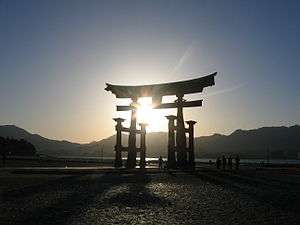
Tame deer amble around the island, harassing tourists for food. While somewhat more restrained than their counterparts in Nara, they're still eager for a hand-out. In the past, waffle-like wafers and pellets could be bought to feed them. However, a feeding ban is now in place, which has led to declining numbers — and increased boldness among the remaining deer, who are willing to root in around bags or backpacks for food (even while said bags are being worn). Further up on Mt. Misen, there are a few deer who have not had their (sharp) antlers removed, so take care if you see one.
A colony of monkeys live on Mt. Misen. There is a clearly (and hilariously) marked viewing point outside the ropeway station at the peak, but the monkeys are usually elsewhere. When they are hanging around by the station, standard monkey rules apply: don't stare, don't leave food around, and don't make sudden movements toward them. They're fairly accustomed to humans wandering around in their domain, though, and aren't likely to take much interest in you, unless you have food in your hands.
While people of most ages and fitness levels can handle the hike to Mt. Misen, it's also not a minor exertion, and there are no guide stations along the way.
If wandering the momiji trail, where the path splits a short way below the lower ropeway station, be mindful not to stray onto private property. However, feel free to go up the stairs and take a picture of the beautiful view. The owner of the restaurant claims that he owns the land on top of that hill, but that is not true. Do not hesitate to refuse his offer for an expensive drink.
Go next
| Routes through Miyajima |
| Yamaguchi ← Iwakuni ← | W |
→ Hatsukaichi → Hiroshima |
| END ← | W |
→ Hiroden Hatsukaichi → Hiroshima st. |